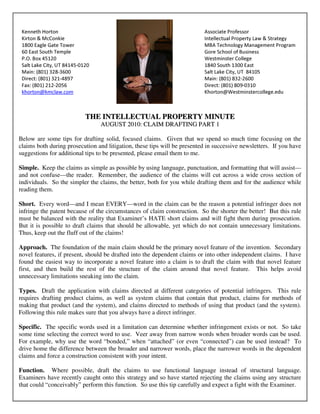
CLAIM DRAFTING TIPS
- 1. THE INTELLECTUAL PROPERTY MINUTE AUGUST 2010: CLAIM DRAFTING PART 1 Below are some tips for drafting solid, focused claims. Given that we spend so much time focusing on the claims both during prosecution and litigation, these tips will be presented in successive newsletters. If you have suggestions for additional tips to be presented, please email them to me. Simple. Keep the claims as simple as possible by using language, punctuation, and formatting that will assist— and not confuse—the reader. Remember, the audience of the claims will cut across a wide cross section of individuals. So the simpler the claims, the better, both for you while drafting them and for the audience while reading them. Short. Every word—and I mean EVERY—word in the claim can be the reason a potential infringer does not infringe the patent because of the circumstances of claim construction. So the shorter the better! But this rule must be balanced with the reality that Examiner’s HATE short claims and will fight them during prosecution. But it is possible to draft claims that should be allowable, yet which do not contain unnecessary limitations. Thus, keep out the fluff out of the claims! Approach. The foundation of the main claim should be the primary novel feature of the invention. Secondary novel features, if present, should be drafted into the dependent claims or into other independent claims. I have found the easiest way to incorporate a novel feature into a claim is to draft the claim with that novel feature first, and then build the rest of the structure of the claim around that novel feature. This helps avoid unnecessary limitations sneaking into the claim. Types. Draft the application with claims directed at different categories of potential infringers. This rule requires drafting product claims, as well as system claims that contain that product, claims for methods of making that product (and the system), and claims directed to methods of using that product (and the system). Following this rule makes sure that you always have a direct infringer. Specific. The specific words used in a limitation can determine whether infringement exists or not. So take some time selecting the correct word to use. Veer away from narrow words when broader words can be used. For example, why use the word “bonded,” when “attached” (or even “connected”) can be used instead? To drive home the difference between the broader and narrower words, place the narrower words in the dependent claims and force a construction consistent with your intent. Function. Where possible, draft the claims to use functional language instead of structural language. Examiners have recently caught onto this strategy and so have started rejecting the claims using any structure that could “conceivably” perform this function. So use this tip carefully and expect a fight with the Examiner.